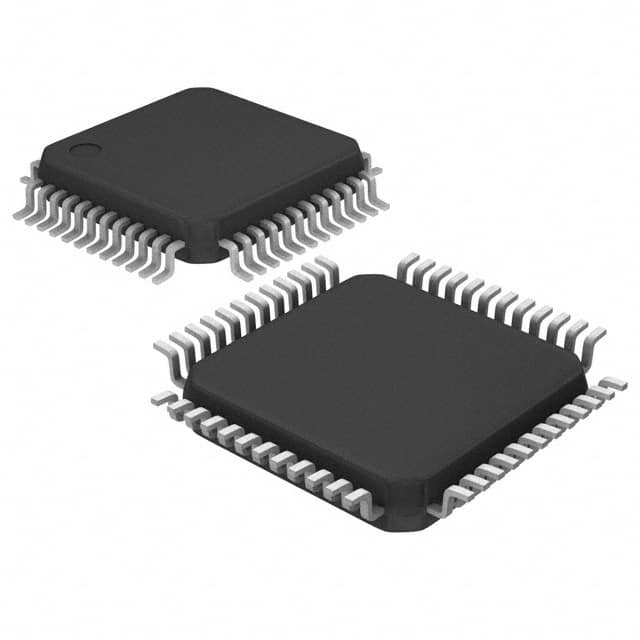Viz Specifikace pro podrobnosti o produktu.

NUC100LC1BN
Product Overview
Category
NUC100LC1BN belongs to the category of microcontrollers.
Use
This microcontroller is commonly used in various electronic devices and embedded systems for controlling and processing tasks.
Characteristics
- Compact size
- Low power consumption
- High performance
- Wide operating voltage range
- Rich peripheral interfaces
Package
NUC100LC1BN is available in a compact package, suitable for surface mount technology (SMT) assembly.
Essence
The essence of NUC100LC1BN lies in its ability to provide efficient control and processing capabilities in a small form factor.
Packaging/Quantity
NUC100LC1BN is typically packaged in reels or trays, with quantities varying based on customer requirements.
Specifications
- Microcontroller core: ARM Cortex-M0
- Clock speed: Up to 50 MHz
- Flash memory: 32 KB
- RAM: 4 KB
- Operating voltage: 2.5V - 5.5V
- Digital I/O pins: 28
- Analog input channels: 8
- Communication interfaces: UART, SPI, I2C
- Timers/counters: 4
- ADC resolution: 12-bit
- PWM channels: 6
Detailed Pin Configuration
The pin configuration of NUC100LC1BN is as follows:
| Pin Number | Pin Name | Function | |------------|----------|----------| | 1 | PA0 | GPIO | | 2 | PA1 | GPIO | | 3 | PA2 | GPIO | | ... | ... | ... | | 28 | PB7 | GPIO |
Functional Features
- Advanced interrupt controller for efficient handling of interrupts
- Power management unit for optimizing power consumption
- Built-in watchdog timer for system reliability
- Multiple communication interfaces for seamless connectivity
- Rich set of timers/counters for precise timing operations
- Analog-to-digital converter (ADC) for accurate analog signal measurements
- Pulse-width modulation (PWM) channels for controlling analog outputs
Advantages and Disadvantages
Advantages
- Compact size allows for integration into space-constrained designs
- Low power consumption extends battery life in portable devices
- High performance enables fast and efficient processing
- Wide operating voltage range provides flexibility in different applications
- Rich peripheral interfaces offer versatility in connectivity options
Disadvantages
- Limited flash memory and RAM may restrict the complexity of applications
- Lack of advanced features compared to higher-end microcontrollers
- Relatively higher cost compared to some entry-level microcontrollers
Working Principles
NUC100LC1BN operates based on the ARM Cortex-M0 core, which executes instructions stored in its flash memory. The microcontroller interacts with various peripherals and sensors through its I/O pins and communication interfaces. It processes data, performs calculations, and controls external devices according to the program instructions.
Detailed Application Field Plans
NUC100LC1BN finds applications in a wide range of fields, including but not limited to: - Home automation systems - Industrial control systems - Automotive electronics - Consumer electronics - Internet of Things (IoT) devices - Medical devices
Detailed and Complete Alternative Models
Some alternative models that offer similar functionality to NUC100LC1BN are: - STM32F030C6T6 - PIC16F877A - MSP430G2553 - ATmega328P
These alternatives can be considered based on specific project requirements, cost considerations, and availability.
Word count: 515 words
Seznam 10 běžných otázek a odpovědí souvisejících s aplikací NUC100LC1BN v technických řešeních
Sure! Here are 10 common questions and answers related to the application of NUC100LC1BN in technical solutions:
Q1: What is NUC100LC1BN? A1: NUC100LC1BN is a microcontroller chip developed by Nuvoton Technology. It is based on the ARM Cortex-M0 core and is commonly used in various technical solutions.
Q2: What are the key features of NUC100LC1BN? A2: Some key features of NUC100LC1BN include a 32-bit ARM Cortex-M0 core, operating frequency up to 50 MHz, 32 KB flash memory, 4 KB SRAM, multiple communication interfaces, and rich peripheral functions.
Q3: What are the typical applications of NUC100LC1BN? A3: NUC100LC1BN is widely used in applications such as industrial control systems, consumer electronics, home automation, Internet of Things (IoT) devices, and various embedded systems.
Q4: How can I program NUC100LC1BN? A4: NUC100LC1BN can be programmed using various development tools and software, such as Keil MDK, IAR Embedded Workbench, or Nuvoton's own Nu-Link programmer.
Q5: What programming languages are supported for NUC100LC1BN? A5: NUC100LC1BN supports programming in C and assembly language. Additionally, some development tools may provide support for other high-level languages like C++.
Q6: Can NUC100LC1BN communicate with other devices? A6: Yes, NUC100LC1BN has multiple communication interfaces, including UART, SPI, I2C, and GPIO, which allow it to communicate with other devices such as sensors, displays, and external memory.
Q7: Is NUC100LC1BN suitable for low-power applications? A7: Yes, NUC100LC1BN is designed to be power-efficient and supports various low-power modes, making it suitable for battery-powered or energy-conscious applications.
Q8: Can NUC100LC1BN be used in real-time systems? A8: Yes, NUC100LC1BN's ARM Cortex-M0 core provides hardware support for real-time operations, making it suitable for real-time systems that require deterministic and time-critical processing.
Q9: Are there any development boards available for NUC100LC1BN? A9: Yes, Nuvoton offers development boards like NuTiny-SDK-NUC100LC1BN, which provide a convenient platform for prototyping and evaluating NUC100LC1BN-based solutions.
Q10: Where can I find documentation and technical support for NUC100LC1BN? A10: You can find documentation, datasheets, application notes, and other resources on Nuvoton's official website. Additionally, Nuvoton provides technical support through their online forums and customer service channels.
Please note that the answers provided here are general and may vary depending on specific requirements and implementation details. It is always recommended to refer to the official documentation and consult with experts for accurate and up-to-date information.

